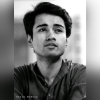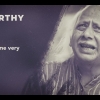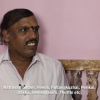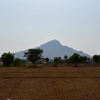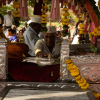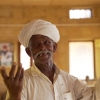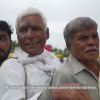Kumkum Mohanty was one for the early disciples of Guru Kelucharan Mohapatra. In the years that followed the Jayantika movement, Mohapatra created many of his signature compositions for Mohanty and Sanjukta Panigrahi. Kumkum Mohanty joined Indian Postal Service in 1970 and left the field of dance. In 1983, she came to Odisha on deputation upon the invitation of J.B. Pattnaik, and she established Odissi Research Centre. While at the helm of Odissi Research Centre, Mohanty collaborated with Guru Kelucharan Mohapatra, Sanjukta Panigrahi, and several music and Sanskrit scholars in preparing a terminology for the basic stances, movements and mudras of Odissi and visually recording each of them. Based on their efforts, Mohanty brought out a manual for Odissi: The Odissi Dance Path Finder. Through her initiative, performances of legendary gurus such as Pankaj Charan das, Debaprasad Das, and Mohapatra were recorded and preserved at Odissi Research Centre. Kumkum Mohanty has performed in all major dance festivals and music conferences across India and abroad. She runs an institute for Odissi dance called Geeta Govinda in Bhubaneswar.
Following is an edited version of the conversation with Kumkum Mohanty conducted by Madhur Gupta in 2018.
Kumkum Mohanty (KM): Guruji composed nearly four dance dramas on Konark. The first one was produced by All India Radio and the concept was again Surendra Mohanty. Many senior students, including my sister, performed. At that time, they were 20 or 22 years old. I was just a kid. We did very small roles. That Konark dance drama was probably in ’58 or ’59. The second Konark dance drama was staged by Guruji himself in Kala Vikash Kendra.
That last one was staged at Konark Festival in probably ’92, with Sonal (Sonal Mansigh), Sanjukta (Panigrahi) and myself. Yes, the three of us danced. It was a huge affair. And Guruji himself played a role. There were nearly 30 girls and boys in it.
As far as I remember, from ’58 ’68, for ten years, stitched costumes were not there. Guruji used to tie the saris for us—for about 25 to 30 girls. If the show started at 6 in the evening, he would start dressing us at 2 in the afternoon. He singlehandedly dressed the girls. He would do the make-up also. There would be make-up man, of course, but for me, though, it was Guruji who did it always. And for my sister also. After wrapping the saris for all these girls, Guruji would get tired. So, my mother called our tailor, who stitched frocks and everything else for our family. My mother, Guruji and the tailor sat down and planned for hours, and, in the process, my mother wasted nearly ten saris. The first costume that was stitched—a silk sari—I wore throughout the entire USSR programme and in Delhi also. It’s still with me. It had long strings which we had to tie around us. From then on, a lot of improvisations were made on the costume. Then the front pleats were stitched. After five or six years—Guruji used to wear dhotis—he asked the tailor, can you stitch the sari like this dhoti? So, it was done.
Madhur Gupta (MG): So, first came the costume with the centre fan, and then afterwards the costume was modelled on the dhoti?
KM: Yes, and the nattuvari (fabric fastened around the hips) was of a different colour. When the centre fan was stitched, the nattu was not stitched, only the blouse and sari were stitched.
MG: You used to wear the nattuvari?
KM: Yes, we used to wear it, but it was of some other cloth.
MG: What about the tahia (headgear worn by Odissi dancers)?
KM: Guruji himself would pluck juhi flowers and make garlands. When there was my sister’s performance, around 3 in the afternoon, I would see him picking juhi flowers and sitting and stringing them on a coconut stem. Not the whole thing, just the spire above the band. The band around the bun was made of fresh flowers. The sholo flowers (crown made of sholapith) came into usage very late.
MG: But why were the fresh flowers replaced?
KM: Real flowers are heavy, you know. So, Guruji went to Puri and asked the craftsmen to make the crown. Then again, the silver jewellery, it was again my mother who asked our goldsmith to make all our dance ornaments. She would herself draw the designs.
MG: You never wore silver on the upper body, right?
KM: Only the bangles, armband and the waist belt were of silver. The ornaments on ears, forehead and the necklace were always gold.
MG: Why was it so?
KM: My mother told Guruji: Look, in our house, ladies do not wear silver above the waist, so I will not allow it. Let her wear gold.
MG: Earlier the odni used to be of Benarasi?
KM: No, only I used to wear Benarasi. Others wore chiffon chunni with zari border.
MG: Where did this concept of odni come from in Odissi dance costume?
KM: I am not sure where it came from. But at that time when Guruji used to drape the sari for us, and when we wore matching blouses, each girl was asked to bring a chunni. We would drape it around us and wear the bengapatia (waist belt).
MG: So, bengapatia was always there.
KM: No, no, in my childhood, bengapatia was not there. Krishnachitraya used to give us a zari belt. Bengapatia was introduced only in ’61 or ’62, and Sanju and I were the first to have it. My mother immediately went to the goldsmith and got it made. Sanju also got it made. And gradually others followed.
MG: When you started dancing as a kid, Odissi was not a recognised classical dance. Could you talk about how it came to attain classical status?
KM: Odissi dance, like Odissi music was not recognised as a classical form then. Even now Odissi music is not recognised. There was seminar on Odissi dance at Central Akademy in Hyderabad. Even then nobody accepted it. But its turning point was the ‘66 Gita Govinda seminar in Delhi, when I did the abhinaya. Everybody liked it and wanted to watch Guruji performing too. Within three months, I got an invitation for an All India Dance Festival to dance with Yamini Krishnamoorthi. Odissi was then recognised only by artists, it was not recognised by any agency or government. The thing is, there is no hard and fast rule. It is the performance that will attract the artist. At the same time, Odissi had all the elements of classicalism—those five main elements of classicalism were all there.
MG: What were the elements?
KM: You must have shastriya evidence (textual and architectural evidence), strong traditions like mahari, goripua, temples-, etc., a grammar system, a rhythm system and then you must have your own music system. Odissi music is the mixture of Hindustani and Carnatic music, that is the central point. The popular songs in Odissi are based on South Indian ragas. At the same time, you can find North Indian influence. But the gamaka (a technical rendering style), there are 32 gamakas in classical system, Odissi has two gamakas.
MG: What makes it Odia?
KM: I tell you, the gamakas make it different, it is the gamakas that give it flavour. I have danced for the last 52 years—Sanju danced across the country and abroad. Everybody said Odissi is a beautiful dance but nobody asked about the music. There is something in that music that made them silent. This soft and wavy gamaka makes the difference. I asked Mishraji (Bhuvaneshwar Mishra): How did you compose Kalyan? He gave a beautiful answer: A maharishi sings Rathisukha Sare in the temple. I just made it in vilambhit (slow paced). So ragas are common to all music systems, the difference lies in the treatment. Brinjal is available throughout the world. But how to make the curry, isn’t it? Vegetables are common, but do they make the same curry everywhere? So, Mishraji took the ragas but treated them in typical Odissi style.
MG: Why do you think there are only two gamakas in Odia music and so many in Hindustani?
KM: In Hindustani and Carnatic, they don’t use everything. There are a hundred karanas (dance poses). How many dance forms use all of them? Similarly, there are 32 gamakas, but even Hindustani or Carnatic music don’t use all of them. Abhinaya Darpana and Natya Shastra are pan-Indian texts. Each classical dance has taken some elements from these texts and mixed with the regional traditions. That is how it has been in classicalism. No dance form has accepted Natya Shastra hundred per cent.
MG: So, you are saying the treatment is what makes them different?
KM: Yes, the treatment is more important. How to develop the raga in Odissi style, that is more important.
MG: But now there is a movement gaining traction for conferring classical status to Odissi music too.
KM: There is a movement but, according to me, there are no singers. If only this movement had taken place when Balkrishna Das was living or Raghunath Panigrahi was living. These two were the jewels. The effort they (artists and scholars) put in Odissi dance, if they had given the same amount of effort for Odissi music, it would have been recognised. There have been five main solo singers in the state. Three of them are no more. The rest are old. They never agreed with one another. They were always at loggerheads. As a result, a single grammar framework could not be worked out in Odissi music, which was possible in the dance because of the efforts of Jayantika.
MG: When we look at the history of Odissi, you have contributed a lot in codifying and archiving it.
KM: Yes. This matter of codifying has always been in my mind. I left dance and went to Mussourie for my training in IPS (Indian Postal Service), came back and took up the job, then had a family. While the dance was composed in our house, while going to the university in the bus, I used to think what if there had been some vocabulary, I could have written down whatever was composed. That was a big question mark. Then, later on, I thought, the atmosphere Guruji got in my parents’ house… that sort of support and comfort should be given to Guruji, Mishraji and Balkrishna Das, under the roof of government. They need support, and then I can do many things. Then I made a scheme. I made a scheme on codification, documentation and dissemination. J.B. Patnaik brought me to the state under probation but none of them understood the scheme, they just made me Director of Culture. I said, I’m not interested. I was holding some director post in Calcutta, what should I do, sit down in meetings and head proceedings, I am not interested. But it helped me. My husband helped me a lot here—he was in government service, an IAS officer— he did all the spadework for setting up Odissi Research Centre, and as Director of Culture, I could see it through. Thus, it was started in ’84.
MG: Who all did you invite? Tell me a little bit about that.
KM: I started with Guruji, of course, then Balkrishna Das and Bhuvaneshwar Mishraji as music gurus, a dance assistant, a pakhawaj assistant, a Sanskrit scholar, an Odia scholar, and an artiste. These were the main people I wanted. And one good artist who could draw. The Sanskrit scholar and the Odiya scholar would explain the meanings. Because I wanted to take students, and they must understand the language. So, with that I started. Mishraji was in Bombay (Mumbai), he was the director of Vividhbharati then. J.B. Patnaik wrote to Information Ministry and brought him back. Balkrishna Das was there. So, like that, when I first started my work in the Archives building, the Secretary of Culture gave me two rooms—one hall and one room for office. He brought two important deputy directors on deputation to manage the office. The first thing I did was to arrange a seminar, a seminar with the participation of all the gurus. Guruji, Pankaj Babu, Deb Babu—three major gurus, three major maharis, Gotipua maestros—and artistes like Sonal Mansingh, Sanjukta Panigrahi, Priyamvada Mohanty and so on till Ramani and Gangadhar. In that seminar, my question to all the gurus was: How did you learn Odissi? Pankaj Babu narrated how he learnt the dance, he went back 60 years. He was 70 at that time. No questions were allowed.
Guruji took the car, went to his village and brought back an old man who was 84 years old. What steps he showed us! I was really amazed. One or two days. Next day, I sat with the video. That was how the first 14 chapters of my book were formed.
The first thing I took up was the foot positions.
MG: How did you codify the foot positions and who named them?
KM: Pandit Leenamani Mishra, who was the palm-leaf expert at Odisha Museum, Bhagavan Ponda—both were Sanskrit scholars—Guruji, Pankaj sir, Sanjukta… there were 6 of us. Then I clicked the photographs of Guruji’s feet. All the foot positions. Foot means toe, flat, heel. With the permutation and combination of toe, heel, flat... we are dancing, nothing else. No other portion of the feet is working. So, whatever footwork we have, the maximum we have, I photographed. Then we all sat down with those photographs and named each of the footwork. Guruji wanted all the names to be in Sanskrit. One thing I must say, Sanjukta really cooperated with me. She used to like me very much. She used to say what I was doing was for posterity was. . . and that there was no selfish interest. Whenever I called her, she would come. Guruji was already a member of the Centre. Mishraji and Pankaj Babu also came. Deb Babu never came. There were three Sanskrit scholars. We sat down and went through the pictures, and named them one by one. The names should satisfy Guruji. Once Guruji approved the name, it was finalised.
MG: Did you work with the existing foot positions or were they also invented during this?
KM: All foot positions were there. But they were codified and given a nomenclature. That was the most important thing. After the foot positions, we went on to the foot movements. Then came the eye movements. We have the neck movements, head movements, eye movements codified in Abhinaya Darpana. But sama (sama bhanga- standing postion), when you are in sama, your eyes are fixed on one point. But I asked Guruji: Aren’t there three or four types of sama? I am praying. That is sama santha. I am angry, Sama angry. Eyes open in amazement, sama vismaya. Is this not to be codified for the posterity? Sama could be of many types.
Charis (small steps in Odissi dance) I never touched. Chari means how you move. It is basically the foot movements. So I focused on foot movements.
I was also conducting seminars on Odissi music to try to codify it. There is a big music college here. They offer courses in music like B. Mus, M. Mus etc. They had three lecturers. All of them spoke about the raga in three different ways. And the externals who came for the examination, he knew the raga in another way. So, who was victimised here? The students. It was the result of this that Odissi music was in a muddled state. I talked to the Information Ministry: Why don’t you give Odissi music national exposure? They asked: Where is your grammar? Even Cuttack Akashwani was not willing to give it time. Different people had different ways of singing the same raga. Unless there is an authentic text, it was impossible to streamline it. I wanted to publish that. As a result, I had to conduct 112 seminars. We formed an eleven-member committee—Markhanda Mohapatra, Raghunath Panigrahi, Balkrishna Das, Bhunvaneshwar Mishra, Beena Mishra, Prafulla Khare, Rakhalmanthi… I asked for the course syllabus at Sangeetha Mahavidyalaya. They had 85 ragas in B.Mus. The teachers had designed the syllabus and composed some songs to teach the raga. They all had brought out their own books. Ultimately, they came on board with me, and finally we were able to codify 66 ragas.
MG: Apart from these seminars, what other activities were happening at Odissi Research Centre then?
KM: We held classes. I made it a point to make sure that the students also learn the musical notation of pallavis. So, we had music classes, rhythm classes, Sanskrit classes, literature classes on Chanda and Chambu, Odia classes, then practical classes. After the office hours, I would also take classes. Otherwise Guruji would—he usually came late, took classes in the afternoon, and it would go on till 9–9:30 in the evening. My next thought was, how to codify the typical poses of Odissi. I photographed Guruji in different poses and movements. Then we sat down to name each of them. Guruji wanted each name to be in Sanskrit and in feminine gender. We were able to give names to 66 poses.
MG: Thank you.

